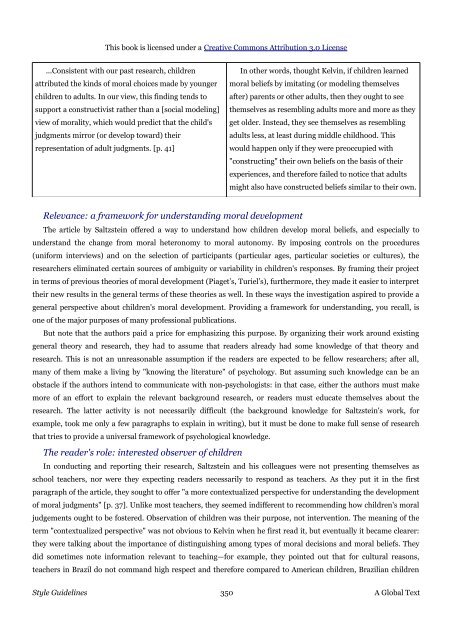Educational Psychology Third Edition Kelvin Seifert and Rosemary ...
Educational Psychology Third Edition Kelvin Seifert and Rosemary ...
Educational Psychology Third Edition Kelvin Seifert and Rosemary ...
Create successful ePaper yourself
Turn your PDF publications into a flip-book with our unique Google optimized e-Paper software.
This book is licensed under a Creative Commons Attribution 3.0 License<br />
...Consistent with our past research, children<br />
attributed the kinds of moral choices made by younger<br />
children to adults. In our view, this finding tends to<br />
support a constructivist rather than a [social modeling]<br />
view of morality, which would predict that the child's<br />
judgments mirror (or develop toward) their<br />
representation of adult judgments. [p. 41]<br />
Relevance: a framework for underst<strong>and</strong>ing moral development<br />
In other words, thought <strong>Kelvin</strong>, if children learned<br />
moral beliefs by imitating (or modeling themselves<br />
after) parents or other adults, then they ought to see<br />
themselves as resembling adults more <strong>and</strong> more as they<br />
get older. Instead, they see themselves as resembling<br />
adults less, at least during middle childhood. This<br />
would happen only if they were preoccupied with<br />
"constructing" their own beliefs on the basis of their<br />
experiences, <strong>and</strong> therefore failed to notice that adults<br />
might also have constructed beliefs similar to their own.<br />
The article by Saltzstein offered a way to underst<strong>and</strong> how children develop moral beliefs, <strong>and</strong> especially to<br />
underst<strong>and</strong> the change from moral heteronomy to moral autonomy. By imposing controls on the procedures<br />
(uniform interviews) <strong>and</strong> on the selection of participants (particular ages, particular societies or cultures), the<br />
researchers eliminated certain sources of ambiguity or variability in children's responses. By framing their project<br />
in terms of previous theories of moral development (Piaget’s, Turiel’s), furthermore, they made it easier to interpret<br />
their new results in the general terms of these theories as well. In these ways the investigation aspired to provide a<br />
general perspective about children's moral development. Providing a framework for underst<strong>and</strong>ing, you recall, is<br />
one of the major purposes of many professional publications.<br />
But note that the authors paid a price for emphasizing this purpose. By organizing their work around existing<br />
general theory <strong>and</strong> research, they had to assume that readers already had some knowledge of that theory <strong>and</strong><br />
research. This is not an unreasonable assumption if the readers are expected to be fellow researchers; after all,<br />
many of them make a living by "knowing the literature" of psychology. But assuming such knowledge can be an<br />
obstacle if the authors intend to communicate with non-psychologists: in that case, either the authors must make<br />
more of an effort to explain the relevant background research, or readers must educate themselves about the<br />
research. The latter activity is not necessarily difficult (the background knowledge for Saltzstein's work, for<br />
example, took me only a few paragraphs to explain in writing), but it must be done to make full sense of research<br />
that tries to provide a universal framework of psychological knowledge.<br />
The reader's role: interested observer of children<br />
In conducting <strong>and</strong> reporting their research, Saltzstein <strong>and</strong> his colleagues were not presenting themselves as<br />
school teachers, nor were they expecting readers necessarily to respond as teachers. As they put it in the first<br />
paragraph of the article, they sought to offer "a more contextualized perspective for underst<strong>and</strong>ing the development<br />
of moral judgments" [p. 37]. Unlike most teachers, they seemed indifferent to recommending how children's moral<br />
judgements ought to be fostered. Observation of children was their purpose, not intervention. The meaning of the<br />
term "contextualized perspective" was not obvious to <strong>Kelvin</strong> when he first read it, but eventually it became clearer:<br />
they were talking about the importance of distinguishing among types of moral decisions <strong>and</strong> moral beliefs. They<br />
did sometimes note information relevant to teaching—for example, they pointed out that for cultural reasons,<br />
teachers in Brazil do not comm<strong>and</strong> high respect <strong>and</strong> therefore compared to American children, Brazilian children<br />
Style Guidelines 350 A Global Text


